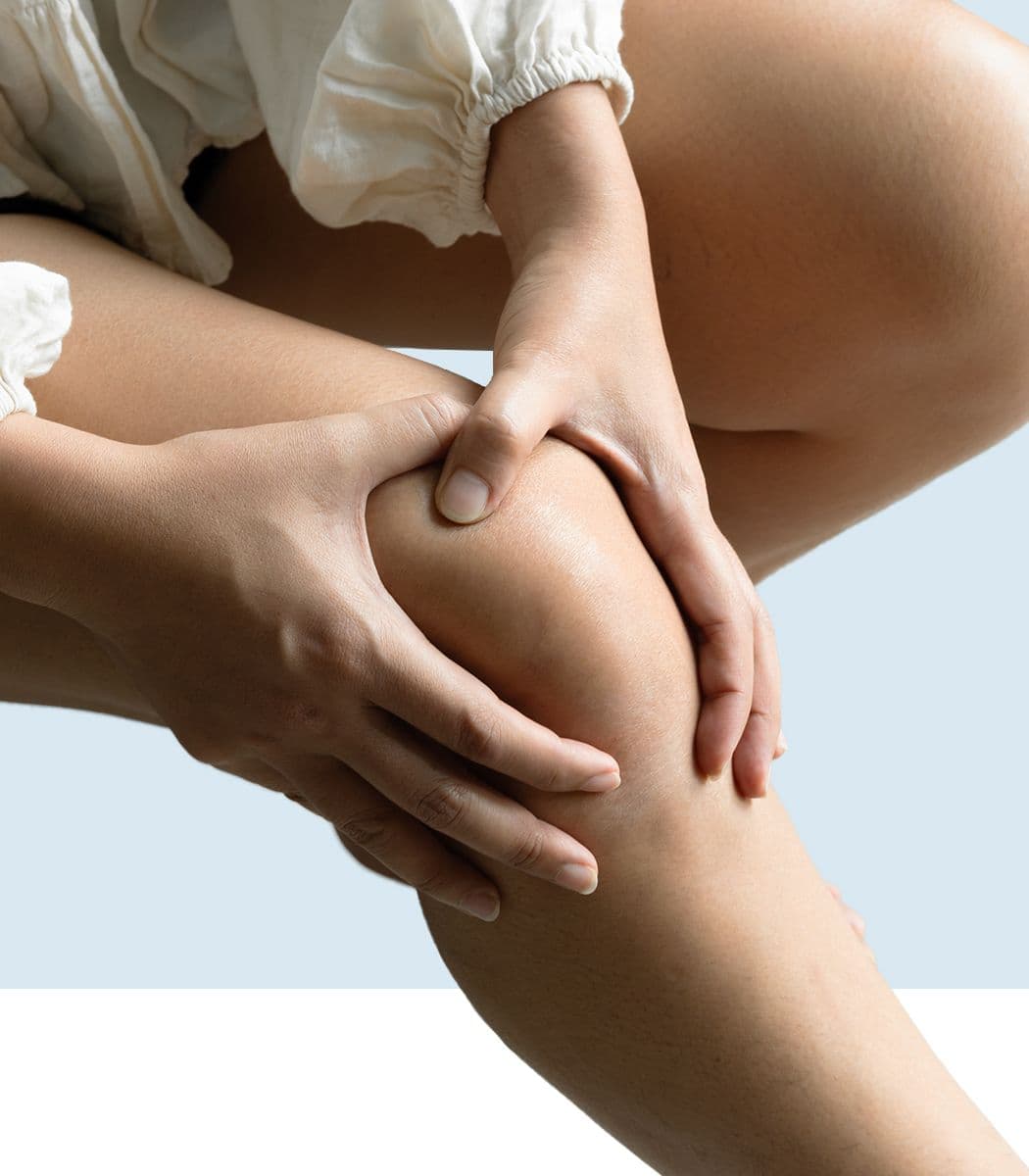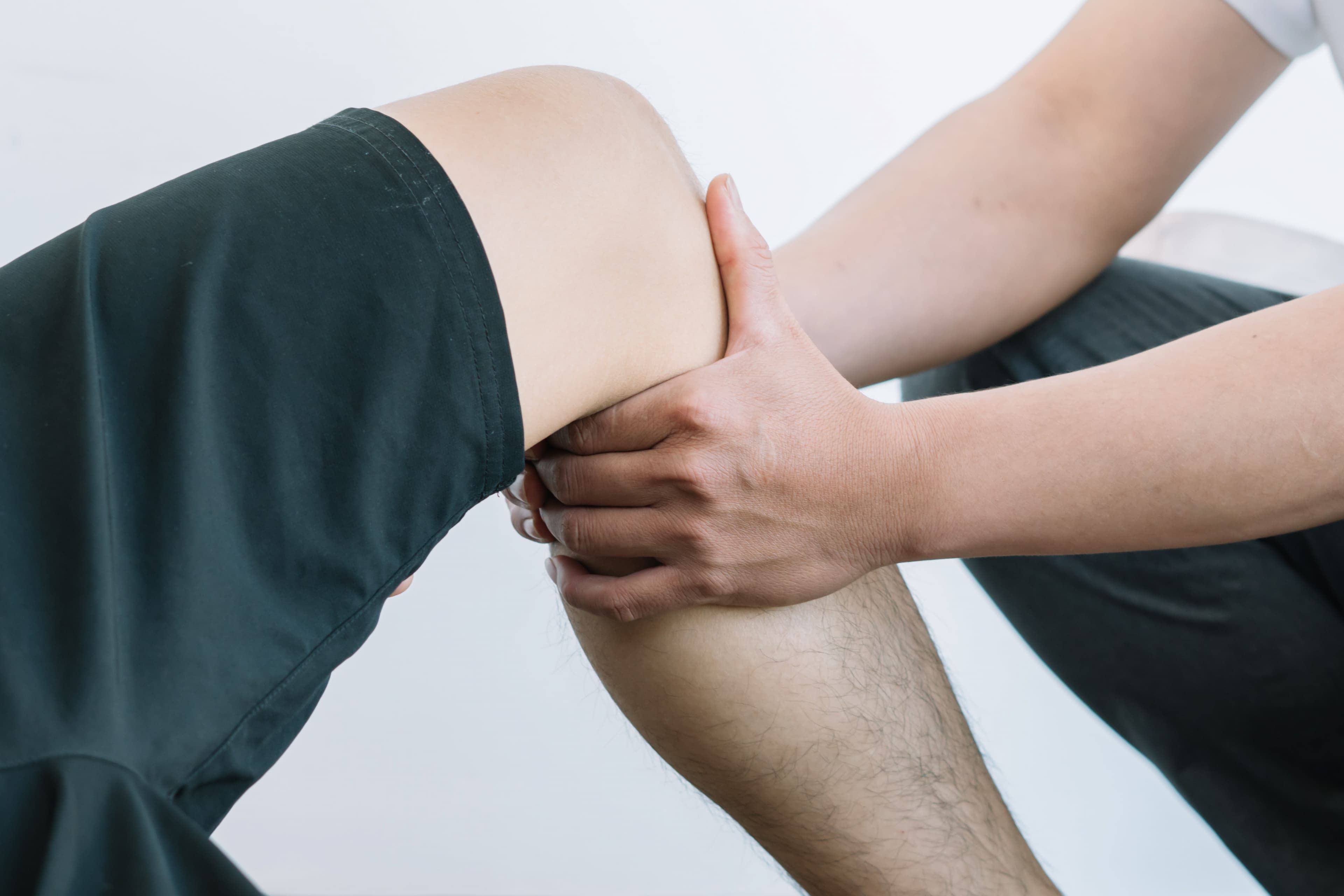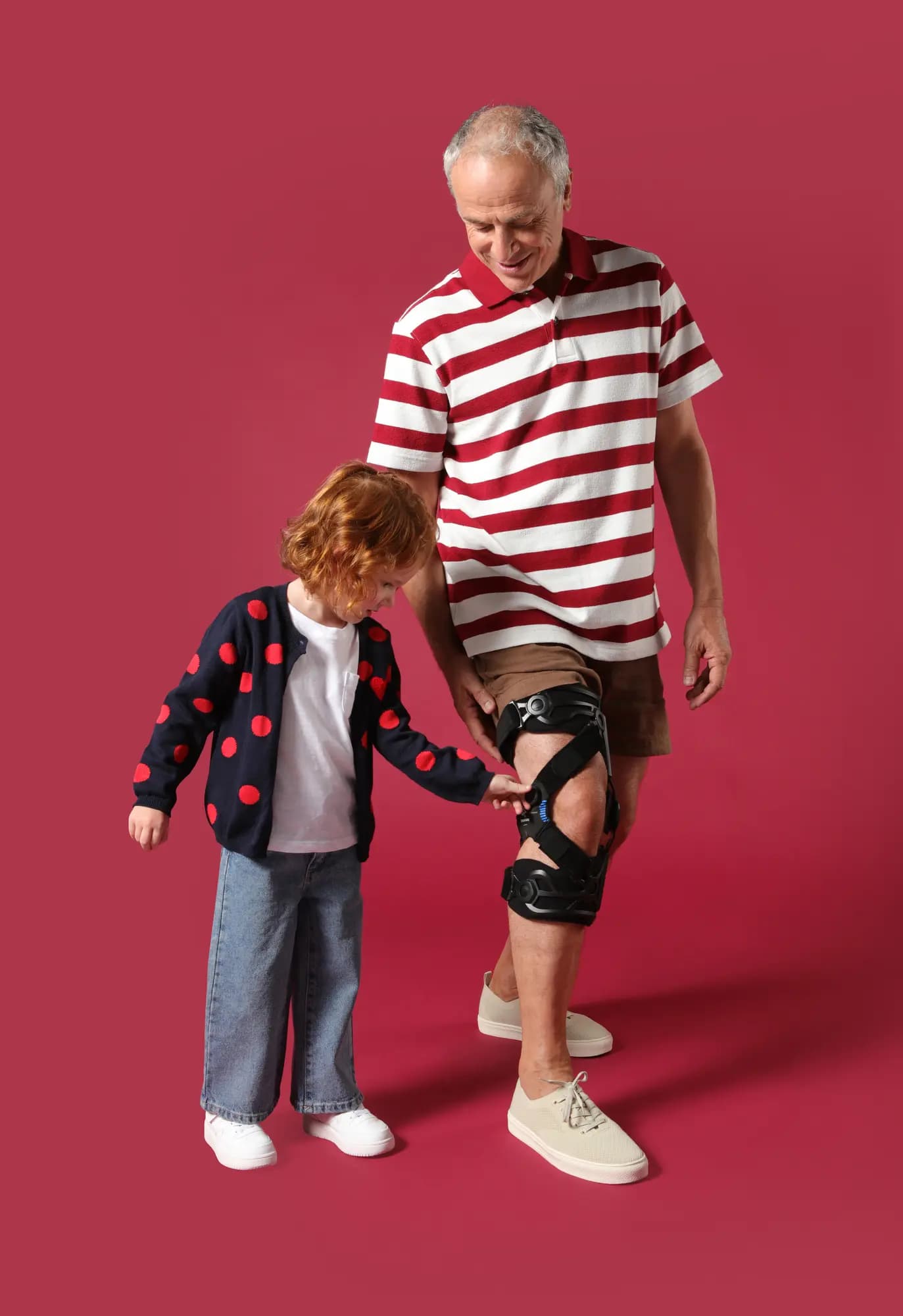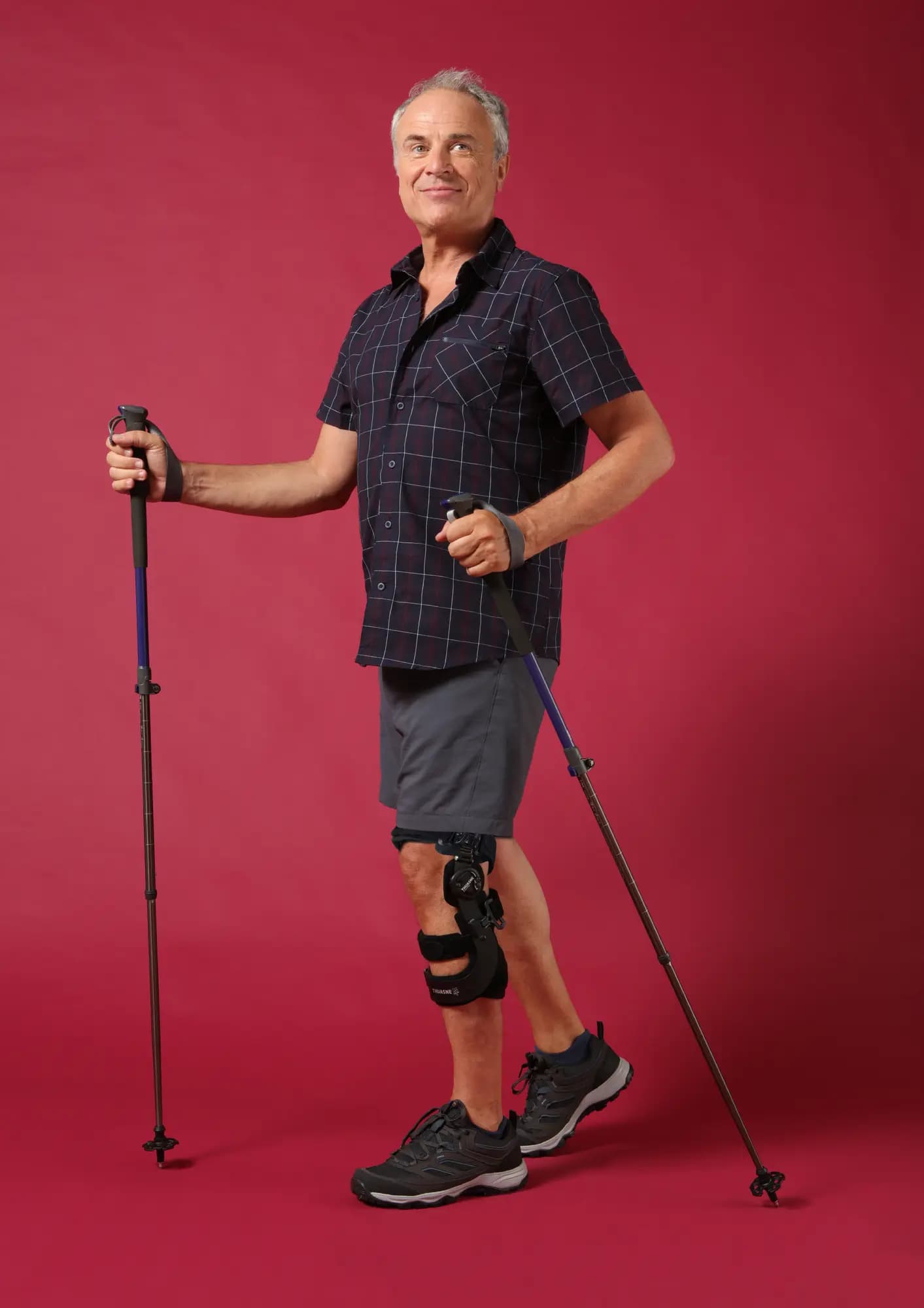Osteoarthritis: Causes, symptoms and solutions

What is osteoarthritis?
Osteoarthritis is a complex disease affecting the entire joint structure, including the cartilage, subchondral bone, ligaments, synovial tissue and surrounding muscles(1). It results mainly from the progressive breakdown of cartilage, the smooth, shock-resistant tissue that covers the ends of the bones in a joint, allowing smooth, pain-free movement. This can lead to pain, stiffness and loss of mobility, as well as inflammation of the joint and deterioration of the surrounding bones(2).
It can affect any joint, but is most common in weight-bearing joints such as the knees, hips and spine, as well as in the hands(4).
What are the different stages of osteoarthritis?
It is possible to classify osteoarthritis of the hip (coxarthrosis) and osteoarthritis of the knee (gonarthrosis) into different radiological stages according to the Kellgren and Lawrence classification. The Kellgren and Lawrence score is a method used to assess the severity of osteoarthritis based on X-rays, taking into account a number of factors such as osteophytes and pinching of the joint space. This classification has four levels: suspected osteoarthritis, mild, moderate and severe.
Suspicion of osteoarthritis(1) is characterised by a doubtful pinching of the joint space, with the appearance of possible osteophytes.
The mild stage(2) shows a probable pinching of the joint space and the appearance of osteophytes.
At the moderate stage(3) there is an appearance of moderate osteophytes, pinching of the definitive joint space, some sclerosis, and possible deformation of the bone ends.
Finally, the severe stage(4) is manifested by the appearance of large osteophytes, a remarkable pinching of the joint space, severe sclerosis and definitive deformation of the bone ends. To find out more about the stages of osteoarthritis, read our article.

What are the different types of osteoarthritis?

Osteoarthritis of the knee (gonarthrosis)
This form of osteoarthritis affects the knee joint, where the femur (thigh bone), the tibia (leg bone) and the patella (also known as the patella) meet (7). There are 2 types of gonarthrosis: patellofemoral osteoarthritis and medial or lateral femorotibial osteoarthritis (2). The knee joint is one of the most complex in the human body, combining movements of flexion, extension and slight rotation (8). Articular cartilage, which covers the bone ends and enables frictionless movement, gradually wears away in osteoarthritis. This wear leads to a loss of the cushioning function of the cartilage and bone damage (2). To find out more, read our article on gonarthrosis.
Understanding osteoarthritis of the kneeUnderstanding osteoarthritis of the knee
Osteoarthritis of the hip (coxarthrosis)
Osteoarthritis of the hip affects the joint between the thigh bone (femur) and the pelvis. This joint is essential for walking, running and maintaining posture, which puts a lot of stress on it. The cartilage in this joint, known as articular cartilage, gradually wears away, leading to bone-on-bone friction, causing pain and inflammation (5).

Osteoarthritis of the thumb (rhizarthrosis)
This specific form of osteoarthritis affects the joint at the base of the thumb (trapeziometacarpal joint), causing pain and loss of strength in the thumb-index pinch (10). It corresponds to the progressive destruction of the cartilage of the joint between the trapezium and the first metacarpal (3,4,11).

Osteoarthritis of the fingers
Osteoarthritis of the fingers is a form of osteoarthritis that affects the joints of the fingers, in particular the distal and proximal interphalangeal joints, as well as the trapeziometacarpal joint. This degenerative condition is characterised by progressive wear of the articular cartilage, leading to pain, stiffness and sometimes visible deformities such as Heberden's and Bouchard's nodules.

Cervical and lumbar osteoarthritis
Cervical and lumbar osteoarthritis affect the joints of the spine in the neck and lower back respectively. Cervical osteoarthritis affects the cervical vertebrae, while lumbar osteoarthritis affects the lumbar vertebrae (14). Symptoms can vary.

Osteoarthritis of the big toe (hallux rigidus)
Hallux rigidus is a form of osteoarthritis that affects the metatarsophalangeal joint of the big toe. It leads to progressive degeneration of this joint, characterised by pain, loss of mobility and often the formation of osteophytes (bony growths) that restrict movement, particularly dorsiflexion.

Osteoarthritis of the shoulders (omarthrosis)
This form of osteoarthritis affects the shoulder joint, involving the humerus (arm bone), the scapula (shoulder blade) and sometimes the clavicle. This complex joint, made up of several sub-units, is often affected by osteoarthritis, particularly in the sternoclavicular joint (59-90% of cases), the acromioclavicular joint (over 50% of cases) and the glenohumearal joint (15-20% of cases) (13).
What causes osteoarthritis?
There are many risk factors favouring the onset of osteoarthritis, including:
Ageing
Osteoarthritis is an age-related degenerative disease, affecting 1 in 3 people over the age of 65. It results from the progressive wear and tear of articular cartilage and a reduction in its ability to regenerate(15).
Heredity
A genetic predisposition can make some people more susceptible to developing osteoarthritis(16).
Joint injuries
Trauma or previous injuries, such as fractures or sprains, can damage the cartilage and joints, increasing the risk of osteoarthritis(16).
Obesity or overweight
Excess weight puts extra pressure on weight-bearing joints such as the knees and hips, accelerating the wear and tear of cartilage(16).
Joint anomalies
Congenital anomalies or joint malformations can predispose a person to osteoarthritis(17,18)
Gender
Women are more affected by osteoarthritis than men, particularly after the menopause(19).

What are the symptoms of osteoarthritis?
The symptoms of osteoarthritis vary depending on the severity and location of the disease, but generally include(9):
Joint pain
Pain can occur during or after movement, and sometimes even at rest(6).
Joint stiffness
Particularly after periods of inactivity, such as waking up in the morning or after sitting for a long time(6).
Loss of flexibility
Decreased range of movement in the affected joint(14).
Sensation of grinding or cracking
Friction of the bones may cause a grinding or creaking noise when the joint is moved(20).
Swelling
Inflammation of the joint can cause swelling around the joint(21).
Deformity
In advanced cases, the joint may become deformed(22).
What are the consequences of osteoarthritis?
Osteoarthritis can have a significant impact on quality of life:
Chronic pain
Stiffness and pain can impair mobility, making it difficult to carry out daily tasks(14).
Reduced mobility
La raideur et la douleur peuvent entraver la mobilité, rendant difficile l'accomplissement des tâches quotidiennes(23).
Functional disability
In severe cases, osteoarthritis can lead to partial or total disability, requiring mobility aids or adaptations to the home environment(23).
Psychological impact
Chronic pain and loss of mobility can affect mental health, leading to feelings of frustration, depression or anxiety(23).
Reduced autonomy
Simple tasks may become impossible without assistance, affecting the person's independence(23).
Did you know ?
+595 millions
of people worldwide would suffer from osteoarthritis in 2020(36).
60%
der Fälle von Osteoarthritis sind Kniearthrosen(37).
60%
of cases of osteoarthritis are knee osteoarthritis(37).
23%
of osteoarthritis cases are osteoarthritis of the hands(37).
FAQ about osteoarthritis
Our medical team answers the questions you may have.
It is advisable to avoid pro-inflammatory foods such as added sugars, saturated fats and processed products. Eating a diet rich in fruit, vegetables, whole grains and oily fish can help reduce inflammation(30). We have an article dedicated to this subject. If you'd like to find out more, don't hesitate to consult it: Osteoarthritis of the knee: better living through diet
To manage osteoarthritis, it is crucial to stay active with suitable exercise, maintain a healthy weight, use support devices if necessary, and follow a treatment plan prescribed by a health professional. Complementary therapies (such as acupuncture, massage or yoga) can also provide additional relief(30).
Osteoarthritis can occur at any age, but is more common in people over 65. However, joint injuries caused by excessive contact stress are common in young adults, with one in 12 people aged between 18 and 44 affected by this type of injury. And it accounts for 12% of cases of osteoarthritis of the lower limbs(16,31,34).
There is no single effective treatment for all patients with osteoarthritis. A multimodal approach that combines medication, biomechanical intervention (wearing an orthosis), physiotherapy, lifestyle modifications and, in some cases, surgery, is often the most effective. Treatment must be tailored to the symptoms and needs of each individual(32).
Rheumatic diseases include a variety of heterogeneous conditions affecting mainly the joints, periarticular structures and tissues of the musculoskeletal system. Some of these diseases affect connective tissue, while others, such as osteoarthritis, rheumatoid arthritis and spondyloarthritis, are mainly joint diseases. Osteoarthritis being the most common form of arthritis, a general term for inflammation of the joints(38).
- Chen, D., Shen, J., Zhao, W., Wang, T., Han, L., Hamilton, J., & Im, H. (2017). Osteoarthritis: toward a comprehensive understanding of pathological mechanism. Bone Research, 5.
- Rehman S, Iqbal S, Umair Shahid M, Soman Jahangir M, Latif Malik A. Cartilage: Structure, Function, and the Pathogenesis of Osteoarthritis [Internet]. Advancements in Synovial Joint Science - Structure, Function, and Beyond. IntechOpen; 2024. Available from: http://dx.doi.org/10.5772/intechopen.1003264
- Cui A, Li H, Wang D, Zhong J, Chen Y, Lu H. Global, regional prevalence, incidence and risk factors of knee osteoarthritis in population-based studies. EClinicalMedicine. 2020 Nov 26;29-30:100587. doi: 10.1016/j.eclinm.2020.100587. PMID: 34505846; PMCID: PMC7704420.
- Long, H., Liu, Q., Yin, H., Wang, K., Diao, N., Zhang, Y., Lin, J. and Guo, A. (2022), Prevalence Trends of Site-Specific Osteoarthritis From 1990 to 2019: Findings From the Global Burden of Disease Study 2019. Arthritis Rheumatol, 74: 1172-1183. https://doi.org/10.1002/art.42089
- Cibulka MT, White DM, Woehrle J, Harris-Hayes M, Enseki K, Fagerson TL, Slover J, Godges JJ. Hip pain and mobility deficits--hip osteoarthritis: clinical practice guidelines linked to the international classification of functioning, disability, and health from the orthopaedic section of the American Physical Therapy Association. J Orthop Sports Phys Ther. 2009 Apr;39(4):A1-25. doi: 10.2519/jospt.2009.0301. PMID: 19352008; PMCID: PMC3963282.
- Lespasio MJ, Sultan AA, Piuzzi NS, Khlopas A, Husni ME, Muschler GF, Mont MA. Hip Osteoarthritis: A Primer. Perm J. 2018;22:17-084. doi: 10.7812/TPP/17-084. PMID: 29309269; PMCID: PMC5760056.
- Jang S, Lee K, Ju JH. Recent Updates of Diagnosis, Pathophysiology, and Treatment on Osteoarthritis of the Knee. Int J Mol Sci. 2021 Mar 5;22(5):2619. doi: 10.3390/ijms22052619. PMID: 33807695; PMCID: PMC7961389.
- Gupton M, Imonugo O, Black AC, et al. Anatomy, Bony Pelvis and Lower Limb, Knee. [Updated 2023 Nov 5]. In: StatPearls [Internet]. Treasure Island (FL): StatPearls Publishing; 2024 Jan-. Available from: https://www.ncbi.nlm.nih.gov/books/NBK500017/
- Rosadi R, Jankaew A, Wu PT, Kuo LC, Lin CF. Factors associated with falls in patients with knee osteoarthritis: A cross-sectional study. Medicine (Baltimore). 2022 Dec 2;101(48):e32146. doi: 10.1097/MD.0000000000032146. PMID: 36482638; PMCID: PMC9726291.
- Colonna S, Borghi C. Rhizarthrosis Part I: A Literature Review. Cureus. 2024 Jan 25;16(1):e52932. doi: 10.7759/cureus.52932. PMID: 38406032; PMCID: PMC10893956.
- McQuillan TJ, Kenney D, Crisco JJ, Weiss AP, Ladd AL. Weaker Functional Pinch Strength Is Associated With Early Thumb Carpometacarpal Osteoarthritis. Clin Orthop Relat Res. 2016 Feb;474(2):557-61. doi: 10.1007/s11999-015-4599-9. PMID: 26493987; PMCID: PMC4709288.
- Roddy, E., & Menz, H. (2018). Foot osteoarthritis: latest evidence and developments. Therapeutic Advances in Musculoskeletal Disease, 10, 103 - 91. https://doi.org/10.1177/1759720X17753337.
- Amber R. Vocelle, Garrett Weidig, Tamara R. Bush, Shoulder structure and function: The impact of osteoarthritis and rehabilitation strategies, Journal of Hand Therapy, Volume 35, Issue 3, 2022, Pages 377-387, ISSN 0894-1130, https://doi.org/10.1016/j.jht.2022.06.008.
- Lindsey T, Dydyk AM. Spinal Osteoarthritis. [Updated 2023 Jul 9]. In: StatPearls [Internet]. Treasure Island (FL): StatPearls Publishing; 2024 Jan-. Available from: https://www.ncbi.nlm.nih.gov/books/NBK553190/
- Loeser RF, Collins JA, Diekman BO. Ageing and the pathogenesis of osteoarthritis. Nat Rev Rheumatol. 2016 Jul;12(7):412-20. doi: 10.1038/nrrheum.2016.65. Epub 2016 May 19. PMID: 27192932; PMCID: PMC4938009
- Loeser RF. The Role of Aging in the Development of Osteoarthritis. Trans Am Clin Climatol Assoc. 2017;128:44-54. PMID: 28790486; PMCID: PMC5525396.
- Geng R, Li J, Yu C, Zhang C, Chen F, Chen J, Ni H, Wang J, Kang K, Wei Z, Xu Y, Jin T. Knee osteoarthritis: Current status and research progress in treatment (Review). Exp Ther Med. 2023 Aug 25;26(4):481. doi: 10.3892/etm.2023.12180. PMID: 37745043; PMCID: PMC10515111.
- He Y, Li Z, Alexander PG, Ocasio-Nieves BD, Yocum L, Lin H, Tuan RS. Pathogenesis of Osteoarthritis: Risk Factors, Regulatory Pathways in Chondrocytes, and Experimental Models. Biology (Basel). 2020 Jul 29;9(8):194. doi: 10.3390/biology9080194. PMID: 32751156; PMCID: PMC7464998.
- Mahajan A, Patni R. Menopause and Osteoarthritis: Any Association ? J Midlife Health. 2018 Oct-Dec;9(4):171-172. doi: 10.4103/jmh.JMH_157_18. PMID: 30692810; PMCID: PMC6332715.
- Song SJ, Park CH, Liang H, Kim SJ. Noise around the Knee. Clin Orthop Surg. 2018 Mar;10(1):1-8. doi: 10.4055/cios.2018.10.1.1. Epub 2018 Feb 27. PMID: 29564040; PMCID: PMC5851845.
- Lindsey T, Dydyk AM. Spinal Osteoarthritis. [Updated 2023 Jul 9]. In: StatPearls [Internet]. Treasure Island (FL): StatPearls Publishing; 2024 Jan-. Available from: https://www.ncbi.nlm.nih.gov/books/NBK553190
- Patel J, Swords M. Hallux Rigidus. [Updated 2023 Nov 22]. In: StatPearls [Internet]. Treasure Island (FL): StatPearls Publishing; 2024 Jan-. Available from: https://www.ncbi.nlm.nih.gov/books/NBK556019/
- The epidemiology and impact of pain in osteoarthritis. Neogi, T. 2013/09/01 2013 ; doi: 10.1016/j.joca.2013.03.018
- Kolasinski SL, Neogi T, Hochberg MC, Oatis C, Guyatt G. 2019 American College of Rheumatology/Arthritis Foundation Guideline for the Management of Osteoarthritis of the Hand, Hip, and Knee. Arthritis Care Res (Hoboken). 2020 Feb;72(2):149-162. doi: 10.1002/acr.24131. Epub 2020 Jan 6. Erratum in: Arthritis Care Res (Hoboken). 2021 May;73(5):764. doi: 10.1002/acr.24615. PMID: 31908149.
- Zeng CY, Zhang ZR, Tang ZM, Hua FZ. Benefits and Mechanisms of Exercise Training for Knee Osteoarthritis. Front Physiol. 2021 Dec 16;12:794062. doi: 10.3389/fphys.2021.794062. PMID: 34975542; PMCID: PMC8716769.
- Katherine Sanchez, Amine Eloumri, Francois Rannou, Serge Poiraudeau, Prises en charge non pharmacologiques et non chirurgicales de l’arthrose : orthèses, exercices, La Presse Médicale, Volume 39, Issue 11,2010, Pages 1172-1179, ISSN 0755-4982, https://doi.org/10.1016/j.lpm.2009.11.022.
- Bliddal H, Leeds AR, Christensen R. Osteoarthritis, obesity and weight loss: evidence, hypotheses and horizons - a scoping review. Obes Rev. 2014 Jul;15(7):578-86. doi: 10.1111/obr.12173. Epub 2014 Apr 22. PMID: 24751192; PMCID: PMC4238740.
- Hunter DJ, Eckstein F. Exercise and osteoarthritis. J Anat. 2009 Feb;214(2):197-207. doi: 10.1111/j.1469-7580.2008.01013.x. PMID: 19207981; PMCID: PMC2667877.
- Wu J, Zhao B, Luo W, et al. Arthroscopy combined with high tibial osteotomy promotes cartilage regeneration in osteoarthritis. Journal of Orthopaedic Surgery. 2023;31(1). doi:10.1177/10225536231165357
- Buck AN, Vincent HK, Newman CB, Batsis JA, Abbate LM, Huffman KF, Bodley J, Vos N, Callahan LF, Shultz SP. Evidence-Based Dietary Practices to Improve Osteoarthritis Symptoms: An Umbrella Review. Nutrients. 2023 Jul 6;15(13):3050. doi: 10.3390/nu15133050. PMID: 37447376; PMCID: PMC10347206.
- Hawker GA, King LK. The Burden of Osteoarthritis in Older Adults. Clin Geriatr Med. 2022 May;38(2):181-192. doi: 10.1016/j.cger.2021.11.005. PMID: 35410675.
- Zheng L, Lu Z, Xu G, Niu X, Zhao J. Dual-targeted disease-modifying therapies for osteoarthritis. Lancet. 2024 Jun 15;403(10444):2591. doi: 10.1016/S0140-6736(24)00475-6. PMID: 38879250.
- MD, M. (2011). The Role of Mechanical Forces in the Initiation and Progression of Osteoarthritis. HSS Journal, 8, 37-38. https://doi.org/10.1007/s11420-011-9251-y.
- Long, H., Liu, Q., Yin, H., Wang, K., Diao, N., Zhang, Y., Lin, J., & Guo, A. (2022). Prevalence, Trends of Site‐Specific Osteoarthritis From 1990 to 2019 : Findings From the Global Burden of Disease Study 2019. Arthritis & Rheumatology, 74(7) 1172‑1183. https://doi.org/10.1002/art.42089
- Global, regional, and national burden of osteoarthritis, 1990–2020 and projections to 2050: a systematic analysis for the Global Burden of Disease Study 2021, Steinmetz, Jaimie D et al. The Lancet Rheumatology, Volume 5, Issue 9, e508 - e522
- Osteoarthritis in 2020 and beyond: a Lancet Commission Hunter, David J et al. The Lancet, Volume 396, Issue 10264, 1711 – 1712
- Ian Kar Yin Lam, Jia Xin Chow, Chak Sing Lau, Vera Sau Fong Chan, MicroRNA-mediated immune regulation in rheumatic diseases, Cancer Letters, Volume 431, 2018, Pages 201-212, ISSN 0304-3835, https://doi.org/10.1016/j.canlet.2018.05.044 et Hawker GA. Osteoarthritis is a serious disease. Clin Exp Rheumatol. 2019 Sep-Oct;37 Suppl 120(5):3-6. Epub 2019 Oct 14. PMID: 31621562
- Salzmann GM, Ossendorff R, Gilat R, Cole BJ. Autologous Minced Cartilage Implantation for Treatment of Chondral and Osteochondral Lesions in the Knee Joint: An Overview. Cartilage. 2021 Dec;13(1_suppl):1124S-1136S. doi: 10.1177/1947603520942952. Epub 2020 Jul 25. PMID: 32715735; PMCID: PMC8808955.
- Aaron RK, Skolnick AH, Reinert SE, Ciombor DM. Arthroscopic débridement for osteoarthritis of the knee. J Bone Joint Surg Am. 2006 May;88(5):936-43. doi: 10.2106/JBJS.D.02671. PMID: 16651566.
- Kwon DG, Chung CY, Park MS, Sung KH, Kim TW, Lee KM. Arthroplasty versus arthrodesis for end-stage ankle arthritis: decision analysis using Markov model. Int Orthop. 2011 Nov;35(11):1647-53. doi: 10.1007/s00264-011-1336-1. Epub 2011 Aug 20. PMID: 21858503; PMCID: PMC3193966.














